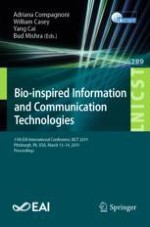2019 | Buch
Bio-inspired Information and Communication Technologies
11th EAI International Conference, BICT 2019, Pittsburgh, PA, USA, March 13–14, 2019, Proceedings
herausgegeben von: Adriana Compagnoni, William Casey, Dr. Yang Cai, Bud Mishra
Verlag: Springer International Publishing
Buchreihe : Lecture Notes of the Institute for Computer Sciences, Social Informatics and Telecommunications Engineering
